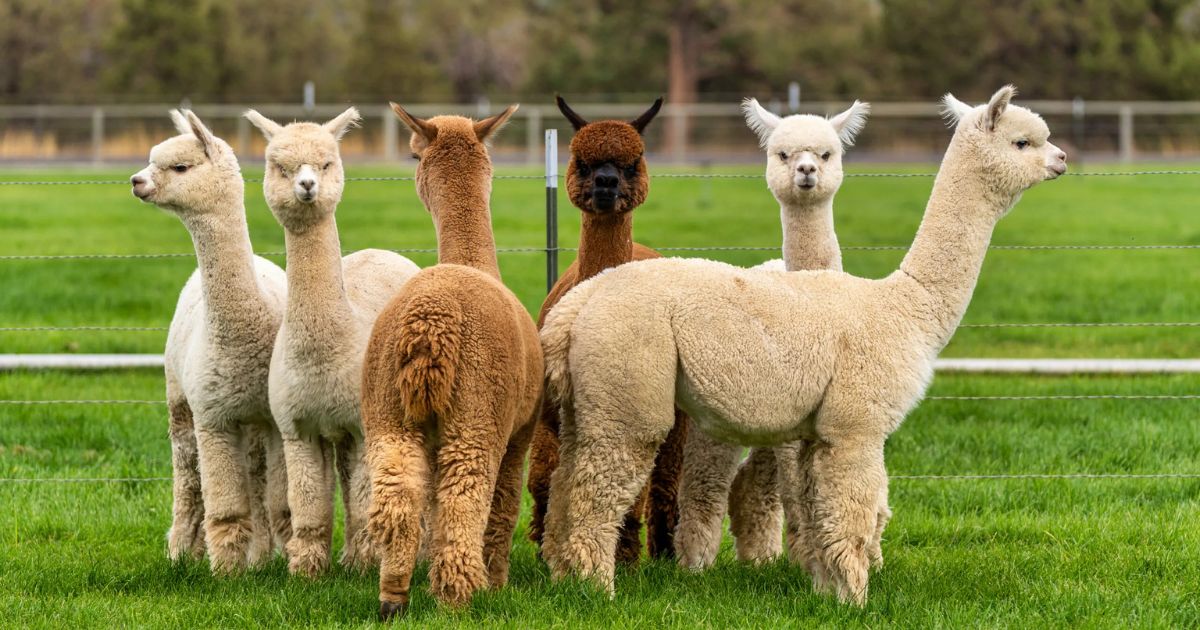Llamas have long captured the human imagination with their quirky charm, fluffy wool, and those soulful eyes that seem to hold ancient Andean secrets. Native to the rugged highlands of South America, these camelids have been domesticated for thousands of years, serving as pack animals, wool providers, and even guardians for herds of sheep. But amid all their endearing qualities, one behavior stands out as both infamous and misunderstood: spitting. If you’ve ever been on the receiving end of a llama’s projectile displeasure—or even if you haven’t—you might wonder, “Why does a llama spit?” This blog post delves into the behavior, unpacking the reasons behind it, the science behind how it occurs, and offers practical insights for anyone who interacts with these fascinating creatures.
Far from being a random act of rudeness, llama spitting is a sophisticated form of communication rooted in their social structure and survival instincts. It’s not just about being “grumpy”; it’s a tool for establishing boundaries, defending territory, and maintaining harmony in the herd. In the wild, llamas’ ancestors, like guanacos, faced predators and harsh environments, evolving behaviors that helped them thrive. Today, domesticated llamas retain these traits, using spit as a non-lethal way to resolve conflicts. But why spit specifically? Evolutionarily, it’s efficient—quick, ranged, and repulsive enough to deter without escalating to physical harm. Spitting allows llamas to conserve energy while sending a clear message. This post will explore the multifaceted reasons behind spitting, from dominance displays to defensive reactions, drawing on insights from animal behaviorists and llama experts.
Llamas and Their Behavior
Llamas (Lama glama) are domesticated members of the camelid family, closely related to alpacas, guanacos, and vicuñas. Native to South America, they have been used for thousands of years as pack animals and sources of fiber. While llamas are generally docile and social creatures, they also have their own unique set of defensive and communicative behaviors. Spitting stands out as the most recognizable, but it is not random. Instead, it is a calculated behavior used in specific contexts. To truly understand what is a mule we must first look at the social lives and instincts of do llamas spit llamas.
Do All Llamas Spit?
The answer is yes—every llama is capable of spitting. However, not all do it often. Some llamas rarely spit, while others may use it more frequently. Spitting is not a constant behavior, but rather one triggered by specific situations. Interestingly, llamas usually direct their spit toward other llamas rather than humans. Humans often get caught in the crossfire when standing between squabbling llamas. This means the behavior is less llama spit about people and more about llama-to-llama rhode island red chicken communication.
What Exactly Is Llama Spit?
When llamas spit, it’s not always the same type of spit. Depending on their level of agitation, they may release different kinds:
- Air Spit – A warning sign where the llama spits just air and maybe a bit of saliva. This is a mild approach and often the first step.
- Green Spit – This is more serious. The llama brings up partially digested food from its stomach (cud) and regurgitates it. This foul-smelling spit is highly unpleasant, designed to repel the target immediately.
The green spit is the llama’s most potent weapon in a social or defensive situation, used sparingly but effectively.
Why Do Llamas Spit? Key Reasons Explained
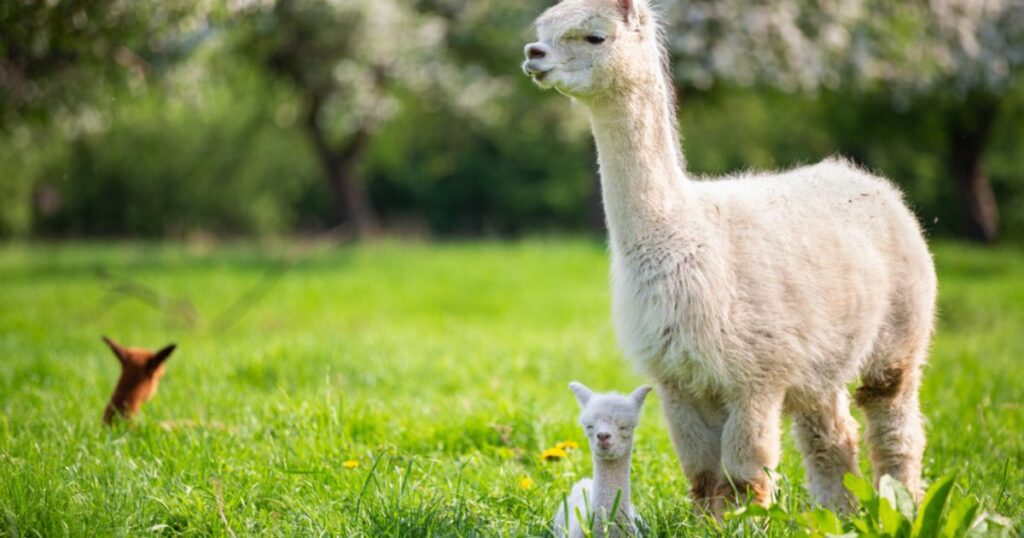 Llamas are fascinating animals known for their gentle personalities, but one behavior often surprises people—spitting. While it may seem unusual, spitting is a natural form of communication for llamas, not an act of random aggression. Llamas primarily spit to establish dominance within their herd, resolve disputes over food, or warn others to back off. This behavior helps them maintain social order without resorting to physical fights. A llama may also spit when it feels threatened, irritated, or stressed, making it a spit llama defense mechanism against perceived dangers.
Llamas are fascinating animals known for their gentle personalities, but one behavior often surprises people—spitting. While it may seem unusual, spitting is a natural form of communication for llamas, not an act of random aggression. Llamas primarily spit to establish dominance within their herd, resolve disputes over food, or warn others to back off. This behavior helps them maintain social order without resorting to physical fights. A llama may also spit when it feels threatened, irritated, or stressed, making it a spit llama defense mechanism against perceived dangers.
Interestingly, spitting is more common among llamas themselves than toward humans, though people may sometimes be caught in the crossfire. The spit is usually a mixture of saliva and stomach contents, delivered with impressive accuracy. By understanding why llamas spit, we can better appreciate their social dynamics and avoid misinterpreting the behavior as hostility. Instead, it reflects their unique way of setting boundaries and maintaining do alpacas spit harmony.
Establishing DominanceDominance
Llamas live in herds with a social hierarchy. Spitting often occurs between males competing for dominance or resources. By spitting, a llama signals displeasure and asserts its position within the group without resorting to physical violence.
Protecting Resources
Food is a common trigger for spitting. If one llama tries to steal another’s share, spitting serves as a clear “back off” message. It helps avoid llama spitting escalation and maintains order in feeding situations.
Mating Disputes
Male llamas may spit when competing for females, while females sometimes spit at males to reject unwanted advances. In this context, spitting is a form of reproductive how far can a llama spit communication.
Defensive Behavior
When a llama feels threatened, especially by predators or intruders, it may spit as a form of defense. While not as dangerous as why do llamas spit biting or kicking, spitting serves as a deterrent to others.
Annoyance or Frustration
Sometimes llamas spit simply because they’re irritated—perhaps by rough handling, another llama being too pushy, or an uncomfortable situation. This is their way of saying “leave me alone.”
Communication Within the Herd
Spitting is part of the llama’s complex communication system. Alongside ear movements, vocalizations, and body posture, spitting provides a clear and unmistakable signal to what animal spits at you.
How Far Can Llamas Spit?
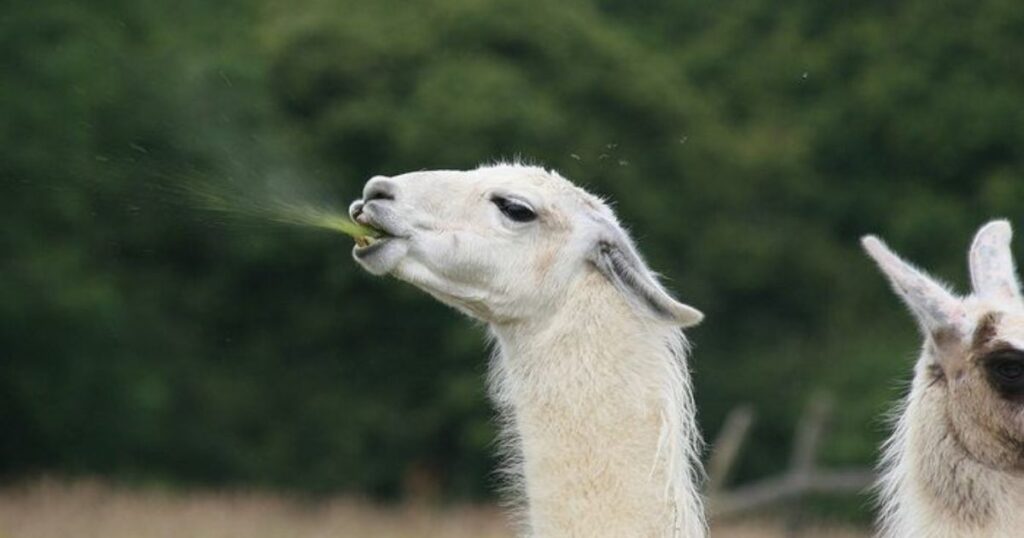
Llamas are fascinating animals known for their unique behaviors, and one of the most surprising is their ability to spit. While spitting is not their first choice, llamas use it mainly as a form of communication, defense, or to establish dominance within the herd. On average, a llama can spit about 10 to 15 feet, though some reports suggest they may reach up to 20 feet when highly agitated. Their spit isn’t just saliva—it often contains partially digested food from their stomach, which makes it smell unpleasant and ensures the message is can alpacas spit clear.
Contrary to popular belief, llamas rarely spit at humans unless they feel threatened or severely provoked. Instead, they primarily target other llamas to resolve disputes over food, space, or hierarchy. Understanding why and how far llamas spit helps people interact with them more respectfully. This behavior is a natural part of their social system, showcasing their intelligence and ability to resolve alpaca spit boer goats conflicts non-violently.
Llama Spitting vs. Alpaca Spitting
Llamas and alpacas are often confused, but both species spit. However, llamas tend to spit more frequently than alpacas. Alpacas usually reserve spitting for disputes over food, while llamas may also use it in dominance battles and defense.
Do Llamas Spit at Humans?
Yes, but rarely out of direct aggression. Most llamas don’t view humans as rivals, so they’re less likely to spit intentionally at people. However, a person can easily become collateral damage when standing between two llamas in conflict. That said, llamas who have been mishandled or mistreated might learn to spit at humans as a form of protest.
The Role of Body Language in Spitting
Body language plays a crucial role in understanding why certain animals, like llamas and camels, spit. Spitting is rarely random; it is a deliberate form of communication often preceded by distinct physical cues. Observing body posture, ear positioning, head movements, and facial expressions can provide early warnings of impending spitting behavior. For instance, a llama may raise its neck, pin back its ears, or tense its body before ejecting saliva as a defensive or dominant gesture.
Similarly, subtle movements such as lip curling, stomping, or tail flicking can signal agitation or territorial assertion. By interpreting these nonverbal signals, caregivers and observers can predict and prevent conflicts, ensuring the safety of both humans and animals. Understanding the interplay between body language and spitting not only enhances animal management but also deepens appreciation for their complex social interactions and emotional expressions.
How to Avoid Getting Spit On
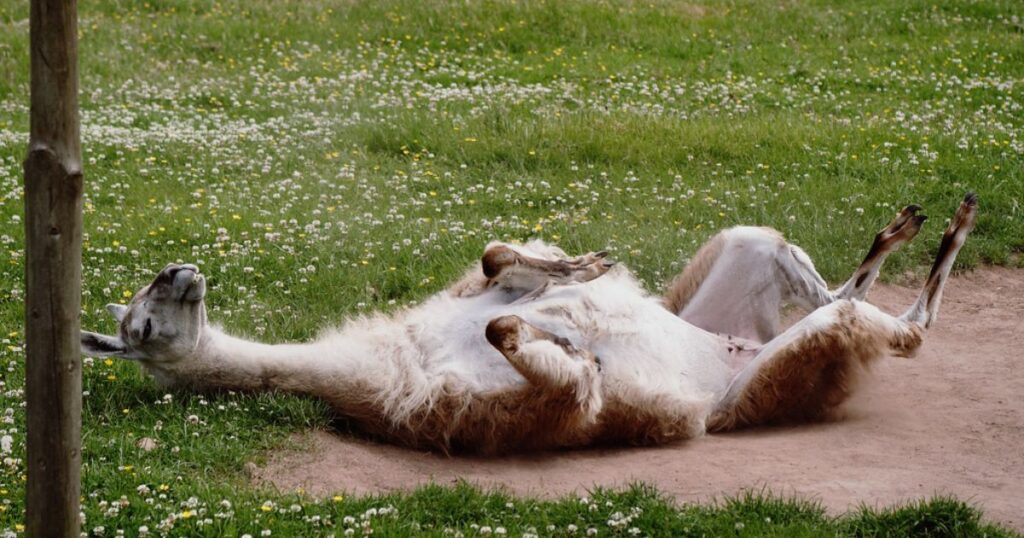 Llamas are fascinating animals, but their habit of spitting can catch people off guard. Fortunately, with the right approach, you can avoid being on the receiving end. First, understand that llamas usually spit to show dominance or express irritation, not simply for fun. Pay close attention to their body language—ears pinned back, head tilted, or gurgling sounds often signal they’re about to spit. Approach them calmly, avoid sudden movements, and refrain from staring directly into their eyes, as this can be perceived as a challenge.
Llamas are fascinating animals, but their habit of spitting can catch people off guard. Fortunately, with the right approach, you can avoid being on the receiving end. First, understand that llamas usually spit to show dominance or express irritation, not simply for fun. Pay close attention to their body language—ears pinned back, head tilted, or gurgling sounds often signal they’re about to spit. Approach them calmly, avoid sudden movements, and refrain from staring directly into their eyes, as this can be perceived as a challenge.
Giving them space, especially during feeding time or when they’re interacting with other llamas, also reduces risk. If you need to handle or care for a llama, do so gently and with respect, rewarding calm behavior with treats. Building trust over time helps llamas feel comfortable around you. By respecting their boundaries and learning their signals, you’ll not only prevent spitting incidents but also develop a positive bond with these unique animals.
Is Spitting Harmful?
While llama spit is unpleasant—especially the green stomach-content kind—it is not harmful. It may smell unpleasant and cause some irritation if it gets into the eyes, but it doesn’tdoesn’t contain dangerous toxins. The primary purpose is deterrence, not injury.
Cultural and Human Perceptions of Llama Spitting
Llama spitting has become a popular stereotype, often exaggerated in movies, cartoons, and memes. While amusing, this stereotype sometimes overshadows the fact that llamas are intelligent, social, and valuable animals. In reality, spitting is just one small part of their complex behavior. In traditional Andean cultures, llamas are respected animals used for carrying loads and providing fiber. Their spitting behavior is understood as a natural form of communication rather than something to laugh at.
Managing Spitting in Domesticated Llamas
Spitting is a natural behavior in llamas, often used to establish dominance, express irritation, or protect their territory. While it’s normal in herds, frequent spitting toward humans can become problematic in domesticated settings. Managing this behavior begins with understanding the triggers—usually competition for food, perceived threats, or discomfort. Handlers should avoid overcrowding, respect personal space, and provide separate feeding areas to reduce rivalry.
Training llamas with consistent, calm handling builds trust and minimizes defensive reactions. Positive reinforcement, such as rewarding calm behavior, is far more effective than punishment, which may increase stress and spitting. Monitoring health is also essential, since pain or illness can cause irritability. Over time, llamas that feel secure, well-fed, and respected in their environment are less likely to spit unnecessarily. While it cannot be eliminated, proper management helps llamas coexist peacefully with humans, making them more enjoyable companions and working animals.
Spitting as Part of Llama Communication
It’s essential to view spitting not as misbehavior, but as a form of language. Just as dogs growl or cats hiss, llamas spit to send a message. For their herd, it is a clear and compelling form of communication that prevents more dangerous conflicts.
Fun Facts About Llamas and Their Spitting
- Llamas prefer not to spit unless necessary—they’d rather warn first.
- Females are often quicker to spit than males when annoyed.
- Baby llamas (called crias) usually don’t spit until they’re older.
- A llama that spits excessively at humans may have been poorly socialized or mishandled.
The Science Behind Llama Spit
 Llamas are fascinating animals, and one of their most unusual behaviors is spitting. At the same time, it may seem like a random act, but spitting has a clear biological and social function. Llama spit is not just saliva—it often includes partially digested stomach contents, making it particularly unpleasant. This defense mechanism helps llamas establish dominance, protect resources, and communicate boundaries within their herd. In the wild, spitting can deter predators or warn off threats, whereas in domestic settings, it typically occurs during disputes over food, territory, or social hierarchy.
Llamas are fascinating animals, and one of their most unusual behaviors is spitting. At the same time, it may seem like a random act, but spitting has a clear biological and social function. Llama spit is not just saliva—it often includes partially digested stomach contents, making it particularly unpleasant. This defense mechanism helps llamas establish dominance, protect resources, and communicate boundaries within their herd. In the wild, spitting can deter predators or warn off threats, whereas in domestic settings, it typically occurs during disputes over food, territory, or social hierarchy.
The act itself is triggered by stress, irritation, or social competition, and the range can be surprisingly far. Scientists believe spitting also reduces physical fighting, allowing llamas to avoid injury while still asserting control. Although humans occasionally get caught in the crossfire, llamas rarely spit directly at people unless provoked. Ultimately, llama spit is a remarkable blend of biology and behavior—an adaptive strategy for survival and social order.
Human-Llama Interactions: When Spitting Targets People
Human-llama interactions can be fascinating, but they come with unique challenges—most notably, the llama’s tendency to spit. While llamas rarely spit without reason, this behavior often occurs as a defensive mechanism, a way to establish dominance, or a reaction to perceived threats. In many cases, spitting is directed toward other llamas. Still, humans can become targets if they encroach on a llama’s personal space, mishandle food, or exhibit behaviors the animal interprets as aggressive.
Understanding the triggers is key to minimizing these unpleasant encounters. Llamas may also spit when stressed, anxious, or trying to communicate discomfort. Observing body language—such as pinned-back ears, raised necks, or lip curling—can help anticipate spitting incidents. For safe and positive interactions, it’s essential to approach llamas calmly, respect their boundaries, and avoid sudden movements. With patience and awareness, humans can enjoy rewarding experiences with llamas while reducing the risk of becoming the target of their signature, and sometimes startling, defense mechanism.
The Mechanics and Science Behind Llama Spitting
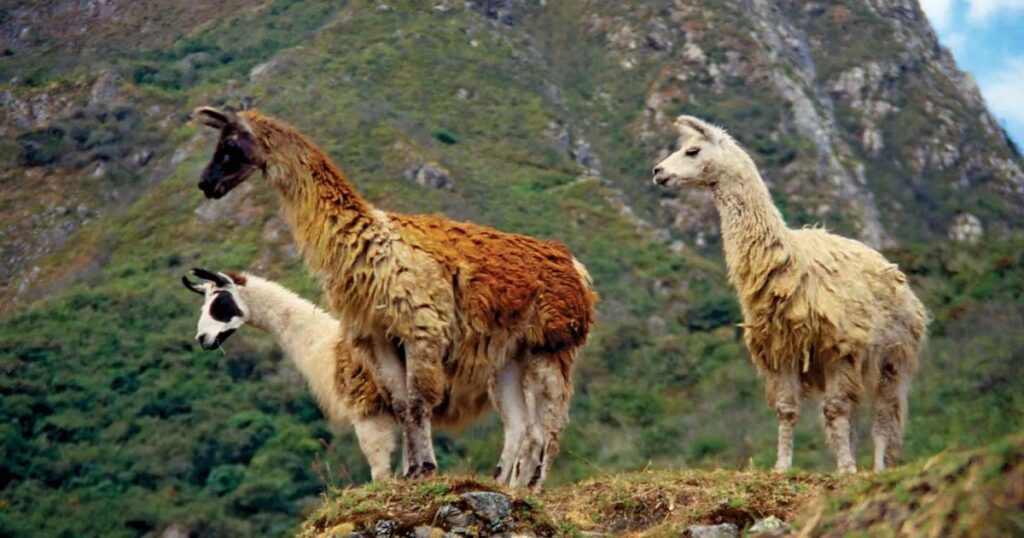 Diving into the “how,” llamas’ spitting leverages their ruminant-like digestion. Unlike true ruminants, camelids have a pseudo-rumen, which allows for regurgitation on demand. The process begins with a threat perception, triggering the autonomic nervous system to contract the esophageal muscles, which pull up contents from the first stomach compartment. Scientifically, this ties to ethology—the study of animal behavior. Researchers note spitting reduces injury risk in social species, similar to primate vocalizations. Hormonally, stress hormones like cortisol spike before spitting, linking it to the fight-or-flight response.
Diving into the “how,” llamas’ spitting leverages their ruminant-like digestion. Unlike true ruminants, camelids have a pseudo-rumen, which allows for regurgitation on demand. The process begins with a threat perception, triggering the autonomic nervous system to contract the esophageal muscles, which pull up contents from the first stomach compartment. Scientifically, this ties to ethology—the study of animal behavior. Researchers note spitting reduces injury risk in social species, similar to primate vocalizations. Hormonally, stress hormones like cortisol spike before spitting, linking it to the fight-or-flight response.
The spit’s composition—acids, enzymes, and plant matter—makes it antimicrobial, potentially deterring infections in wounds, although it is primarily used for offensive purposes. Distance is achieved through forceful expulsion, aided by the muscles in the neck and throat. Comparatively, alpacas spit similarly but less forcefully, while camels’ spits are drier. This highlights the adaptations of camelids to arid environments, where water conservation is crucial.
Conclusion:
So, why does a llama spit? The answer lies in communication, defense, and social order. Spitting allows llamas to express dominance, protect resources, reject advances, and deter threats—all without resorting to violence. For humans, the key takeaway is that spitting is not an act of random aggression, but rather an essential behavioral tool. By respecting llamas’ signals and giving them space, we can coexist more peacefully with these fascinating animals. Llamas may be known for their spit, but they deserve recognition for much more—their loyalty, intelligence, and long history as human companions.
FAQ:
Do llamas Really Spit?
Yes, llamas do spit. It is a natural behavior they use to communicate, set boundaries, or express discomfort. While it may seem aggressive, it’s usually a warning rather than a harmful attack.
Why do llamas spit at People?
Llamas typically spit at humans if they feel threatened, annoyed, or stressed. It can also happen if they are protecting their food or personal space. Young llamas are more likely to spit during training or when interacting with humans.
Do llamas Spit at other llamas?
Absolutely. Llamas use spitting to establish social hierarchy, show dominance, or resolve conflicts within their herd. It’s common for an alpha llama to spit at subordinates to assert authority.
What exactly is in llama spit?
Llama spit is usually a combination of saliva and partially digested food. While it can be messy, it’s generally harmless to humans. The spit is mainly a deterrent, not meant to cause injury.
Is spitting a sign of Illness in llamas?
No, spitting is usually normal behavior. However, excessive spitting, combined with other unusual behaviors such as lethargy or loss of appetite, may indicate stress or health issues, so a vet check is recommended.







